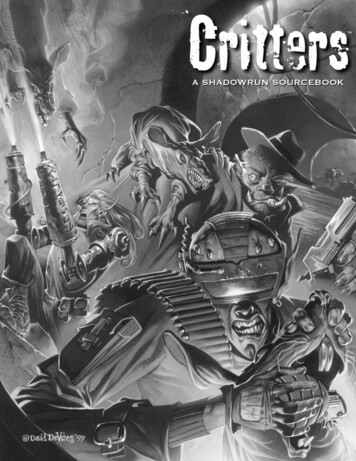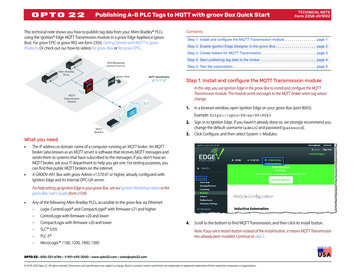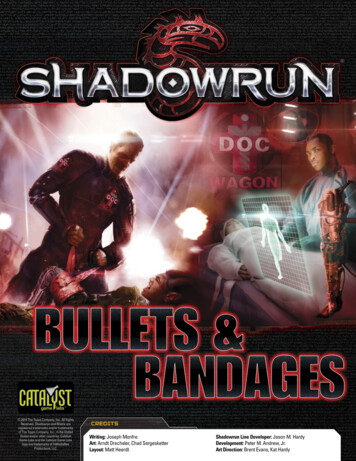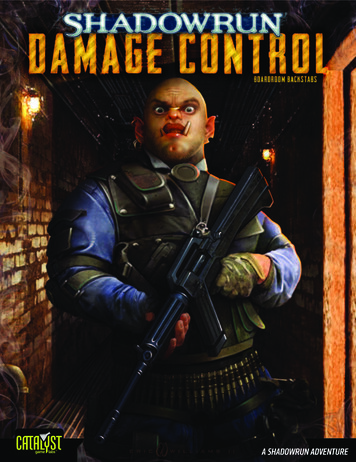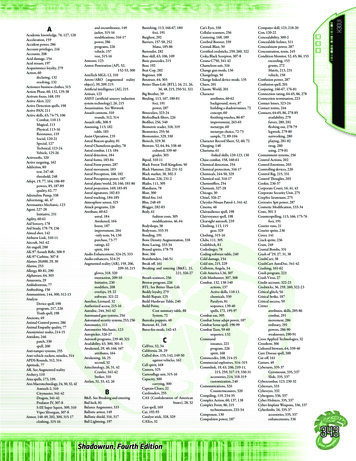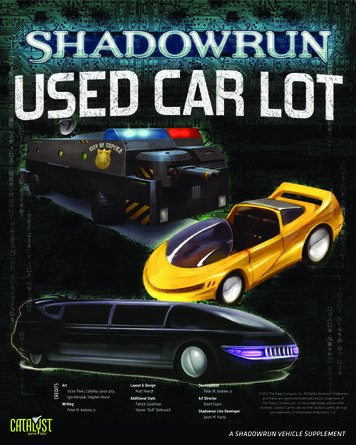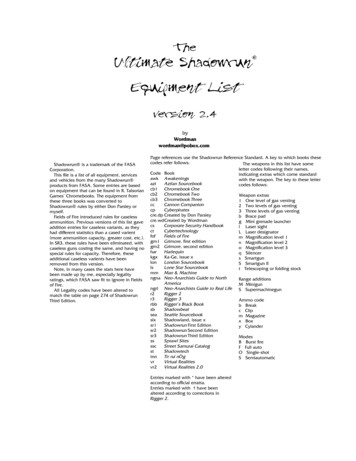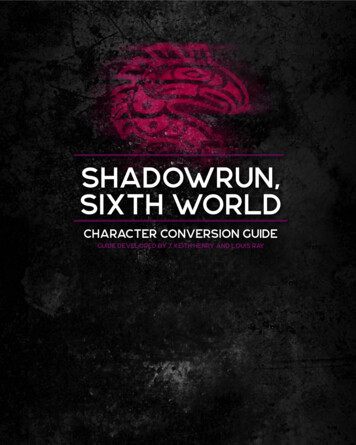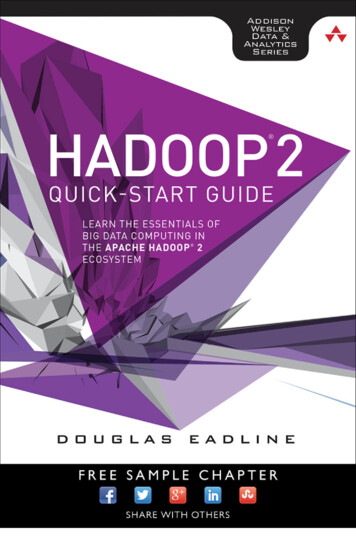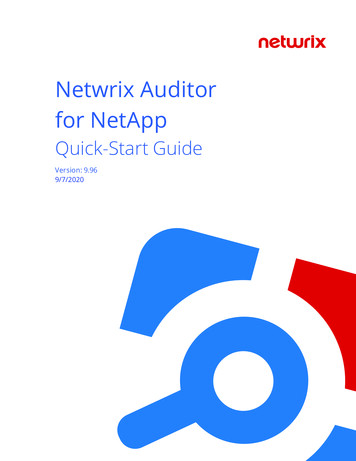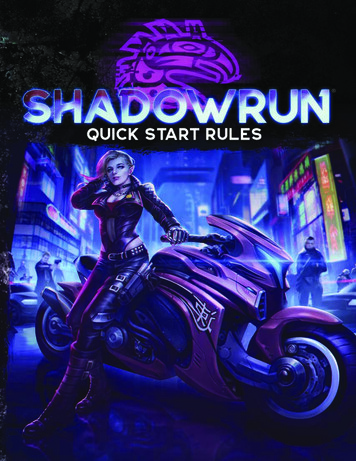
Transcription
QUICK-START RULESIntroductionQuick-Start RulesWelcome to roleplaying in the Sixth World! In Shadowrun,you roleplay as criminals in a dystopian future filled with magic,fantastic creatures, and artifacts, trying to score a big heist whileavoiding the omnipresent megacorporations who control it all.Maybe your next score will be your last, or perhaps you’ll livelong enough to become a street legend. There’s only one way tofind out what your fate will be.At its heart, Shadowrun allows friends to have fun and tellstories together in a cyberpunk/fantasy future. Imagination, creativity, and a bit of luck all come together, along with one ofthe most enduring settings in roleplaying history, to co-createadventures and have a good time.The Shadowrun rules provide a framework for telling thesestories and a way to guide the narratives so that the actionsof the people playing have meaningful consequences within thestory. Player characters (PCs) are the main characters in thatstory, while a gamemaster arranges the major beats, the setting,props, and any non-player characters (NPCs) the players mayencounter. Gamemasters describe the action, players roll six-sided dice to determine whether their actions succeed or not, andthe gamemaster describes the results. Everything is possible inShadowrun, but a character’s abilities and the roll of the dicemake their actions more or less likely.As a team of shadowrunners, the players might break intoa secret lab, infiltrate a gang, extract an asset, steal secure data,or even permanently deal with a hated rival. The characters cansolve mysteries, find rare artifacts, take unsavory jobs, or workwith the downtrodden against the powers that be. A game ofShadowrun has no definitive time limit. A session can be justa few hours, but the stories themselves can continue as long asa group wants to keep playing: daily, weekly, or monthly, evenover the course of years. As players succeed, or fail, their characters grow, and so do their adventures. This Beginner Box givesyou enough to dip your toes into the Sixth World, but there ismuch more out there. The full Shadowrun, Sixth World corerulebook contains many more game options and world details,while supplemental Shadowrun books will be released to giveboth players and gamemasters more material to work with,helping everyone around the table engage with the Sixth Worldand their characters in more detail. Whether or not the groupalways completes their task isn’t the point. If a memorable storywas told and everyone has fun, the entire group wins.This book of quick-start rules (QSR) was designed so youcould hit the ground (shadow)running with the game. Once everyone is ready, you can launch into the adventure, which willhave you practicing the basic concepts of the game. The gamegets easier the more you play! Certain concepts are discussedin sidebars for easy reference, and include definitions, tips andtricks, and examples of gameplay.Important Terms: The first time an important term appearsit is bolded.The Rhythm of a GameShadowrun is a game of setting up situations, rolling a handful of dice based on selected actions, and responding to the results. These rules are here to help tell those stories and makeconsequences feel important—not to limit the stories or the fun.GAMEMASTERAs described above, the gamemaster arranges the major beatsof the story, the setting, props, and plays any non-player characters (NPCs) the players may encounter. Gamemasters describethe action, players roll six-sided dice to determine whether theiractions succeed or not, and the gamemaster describes the results.The person who takes the role of gamemaster is decided byeach gaming group. If no one has tackled the job before, say forother roleplaying games, anyone can step up to the plate. Justthoroughly review the rules and adventure, take good notes asneeded, and be willing to dive into the experience!The BasicsShadowrun’s gameplay uses six-sided dice, or D6, so anytimeyou see a number before a D6, that means you should roll thatmany dice. For example, 4D6 means you should be rolling 4six-sided dice. A test is a roll of dice with the aim of getting enoughhits to meet or exceed the action’s threshold. A hit is defined as a 5or a 6 on a die. The number of dice you roll is determined by themost relevant skill and its linked attribute, so if you try to shoot atroll with your Uzi, you use the Firearms skill, or if you’re tryingto talk a bar owner into giving you free drinks, make a test withthe Influence skill. With practice and experience, these basic testsflow smoothly. While you’re learning the ropes, however, use thefollowing steps to get into the rhythm:1. The gamemaster Describes the Situation.2. The players describe their action and Roll Dice.3. The gamemaster Describes the Outcome. //QUICK START RULES
1. Describe The SituationSHADOWRUN: BEGINNER BOX2Before any dice are rolled, the gamemaster takes timeto set up the action. They may ask for player input or simply describe the situation the players find themselves in.This part of the game can take a very short time, or maylast an extended period of time if everyone is having funroleplaying. At a certain point, however, a player is goingto take an action where the outcome is not certain, andthat’s where the tests come in. Walking, talking, or doingany other number of routine actions don’t require tests.Combat, spellcasting, or other more complex or difficultactions do. When a gamemaster decides the outcome of anaction is uncertain, they ask for a test. If the action has noconsequences for failure, there’s likely no need for a test.A leisurely drive through a small town at mid-morningshouldn’t require a test. Racing another vehicle throughrush-hour traffic while shooting behind you and ditchingthe police? Yeah, that’s a test (or a few of them).2. Roll DiceOnce the gamemaster decides that an action requiresa test, the gamemaster and player decide together whichskill is appropriate for that action. Generally, the gamemaster determines the skill, though players should feel free tomake a case for a different skill. In the end, though, thegamemaster gets to make the callUsually, a skill has a linked attribute associated with it.So Firearms, for example, uses the Agility attribute.Once the skill is determined, the gamemaster sets the test’sthreshold. The threshold describes the complexity and challenge of the action. To help determine how hard a test shouldbe, check the Threshold Guidelines sidebar on page 5.The gamemaster should feel free to apply whatevermodifiers they like to the threshold based on the currentcircumstances.SKILL RANKS DICESkill ranks range from 1 to 9. The rank a character hasin a particular skill is the number of dice they will add to atest using that skill. Furthermore, each skill has an attribute linked to it, which increases the number of dice usedfor that test; see Linked Attributes, below. Specializationsand Expertise in skills further increase the number of dicerolled for a test by 2 and 3, respectively. Specializationsand Expertise in a skill, on the pre-gen character sheets,are indented underneath the corresponding skill.LINKED ATTRIBUTESQUICK STARTEvery character in Shadowrun has at least ten attributes: eight normal and two to three special. The normal attributes are Body, Agility, Reaction, Strength, Will,Logic, Intuition, and Charisma. The special attributesare Edge, Magic, and Essence. All of these attributes arediscussed in greater detail later. The important thing toremember is that each skill has an attribute linked to it.That means that whenever you make a test using a skill,you are also using that skill’s linked attribute. For example, the Firearms skill’s linked attribute is Agility, whichmeans whenever a player rolls a Firearms test, they addtheir ranks in Firearms to their attribute rank, and rollthat many dice. On the pre-gen character sheets, eachskill’s dice pool is pre-calculated in the DP column, whilethe NPC stats include the dice pool as a single value listed after each skill. For additional reference, see the Skillsand Linked Attributes table (p. 23).RULES // Once you know what skill the action will use and thethreshold, the player adds their rank in that skill the appropriate linked attribute rank and rolls that many dice.For explanations of skill ranks and linked attributes, seethe sidebars on this page.Once the dice are rolled, note any 5s or 6s amongthem. These are called hits. Take note of any 1s as well. Ifmore than half the dice show a 1, the roll is a glitch (seeGlitches, below). If the number of hits (5s or 6s) is equalto or greater than the threshold, the player succeeds inwhat they were attempting. If they get fewer hits than thethreshold, they fail.GLITCHESWhen more than half the results on a test are 1s, theresult is a glitch. A glitch means something goes wrong.A glitch isn’t catastrophic, however. Think of glitches asopportunities for gamemasters and players to narratehow an action had an unexpected result, complication,or embarrassment, even if it succeeded. In fact, it is possible to succeed at a test by meeting the threshold andstill have a glitch. This would mean the player succeedsin the task, but something unexpected also happened. Itis up to the gamemaster (or the player, if the gamemaster allows) to describe what the complication is.3. Describe the OutcomeOnce the outcome of the test is determined, the gamemaster describes the results, providing any relevant consequences of success or failure. Then the gamemaster startsagain at step one and describes the next situation until anew test is called for.That is the whole process for a Simple test. More detailed rules for tests, including rules for variations likeCombat/Opposed tests, are found starting on page 5. However, in order to really get moving into the rules, you’ll needto understand characters.CharactersPlayer characters (PCs) and non-player characters(NPCs) act as the cast for the stories your group will telltogether. Players control PCs and have full page charactersheets (found on pages 2 and 3 of each dossiers), and thegamemaster controls NPCs, which have shortened character stats (such as those found in the back of Battle Royale,the adventure in this box, as well as their correspondingNPC cards). A character’s measurable traits, the ones thataffect the game directly, are recorded on character sheets.Character SheetsA character sheet is where a PC’s game statistics arerecorded. These stats abstract a character’s physical andmental traits into numbers and information to use in Shadowrun’s game system. When your character moves, fights,interacts, and speaks, all the game info about how to dothose things is listed on the character sheet. The character sheet also tracks any damage your character has taken, as well as their ammo, equipment, and allies. For thesequick-start rules, pre-generated character sheets have beenprovided, with their game statistics pre-loaded, so you canstart playing right away. As mentioned, you can find themon pages 2 and 3 of each character dossier. The statistics,numbers, and other information on the character sheets aredescribed in detail next.
MetatypeCharacters in these rules fit one of five metatypes. Thefive variants are humans, elves, dwarfs, orks, and trolls.Non-humans are known as metahumans, while the five subgroups as a whole (including humans) are known as metahumanity. In the 2080s, humans are still the most numerous.3SHADOWRUN: BEGINNER BOXDwarfs (Homo sapiens pumilionis)Known for: Short size; stocky build; perseveranceElves (Homo sapiens nobilis)Known for: Slender, lithe builds; being attractiveand knowing itHumans (Homo sapiens sapiens)Known for: Average size; average build; freakingout about people who don’t meet their averagesOrks (Homo sapiens robustus)Known for: Big, powerful, physique; tusks; constantly being seen as outsidersTroll (Homo sapiens ingentis)Known for: Being so big, you guys. Just huge. And horns.AttributesAttributes represent the character’s inherent traits, bothwhat they were born with and what they developed overtime. In these quick-start rules, some characters possess tenattributes, while some have eleven. There are four Physicalattributes, four Mental attributes, and three Special attributes. All characters have four Physical and four Mentalattributes. The number of Special attributes is either two orthree, depending on if you can use magic or not.Physical AttributesBody represents a character’s physical resistance, fitness, immune system, muscle, bone strength, and overallhealth. Agility determines a character’s hand-eye coordination, manual dexterity, flexibility, balance, and fine motorcontrol. Reaction expresses physical reflexes and responsetime. A character’s Strength represents their raw muscularability, including how hard they hit, how much they canlift, or how fast they can run.Mental AttributesWillpower represents the character’s ability to keep going when they want to give up. It enables them to pushthrough pain and deception and allows them to controlhabits and emotions. Logic is the cold, calculating part ofthe mind: rational, analytical, and problem-solving. Intuition covers gut instinct, inspiration, and insight that helpsa character avoid danger and perceive threats. A character’s Charisma abstracts the combination of looks, speaking ability, fashion sense, or a combination of those thingsinto a certain je ne sais quoi that allows them to exert socialinfluence over people.Special AttributesEdge measures the undefinable combination of luck,risk, fate, and ignorance of danger that lets shadowrunners perform amazing feats and stay alive where otherswould have gone splat. Edge has its own, more detailedexplanation in the Getting into the Action section (p. 6).Magically active characters have an attribute called Magic, //QUICK START RULES
SHADOWRUN: BEGINNER BOX4which measures their ability to wield mana and twist thesupernat
while supplemental Shadowrun books will be released to give both players and gamemasters more material to work with, helping everyone around the table engage with the Sixth World and their characters in more detail. Whether or not the group always completes their task isn’t the point. If a memorable story was told and everyone has fun, the entire group wins. Quick-Start Rules This book of .
